The ground offensive will get started soon despite secondary activity like Russia conscripting civilians in violation of Geneva conventions. “Despite increased activity, Russian forces have made no major gains in the last 24 hours as Ukrainian counter-attacks continue to hinder their efforts.” Bombardment continues and there is analysis indicating deployment of more advanced Russian weaponry that was held in reserve from the initial incursion. Further evidence of atrocities in mass graves has been identified.

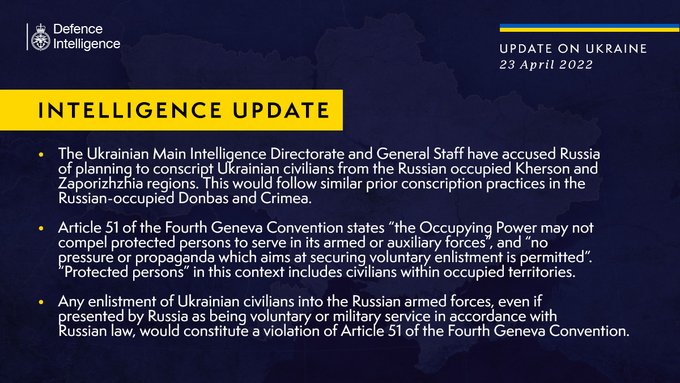
Immediate items to watch
- Russian forces will likely continue attacking southeast from Izyum, west from Kreminna and Popasna, and north from Donetsk City via Avdiivka or another axis.
- Russian forces will attempt to starve out the remaining defenders of the Azovstal Steel Plant in Mariupol and will not allow trapped civilians to evacuate.
- Russian forces will likely increase the scale of ground offensive operations in the coming days, but it is too soon to tell how fast they will do so or how large those offensives will be. It is also too soon to assess how the Russians will weight their efforts in the arc from Izyum to Donetsk City.
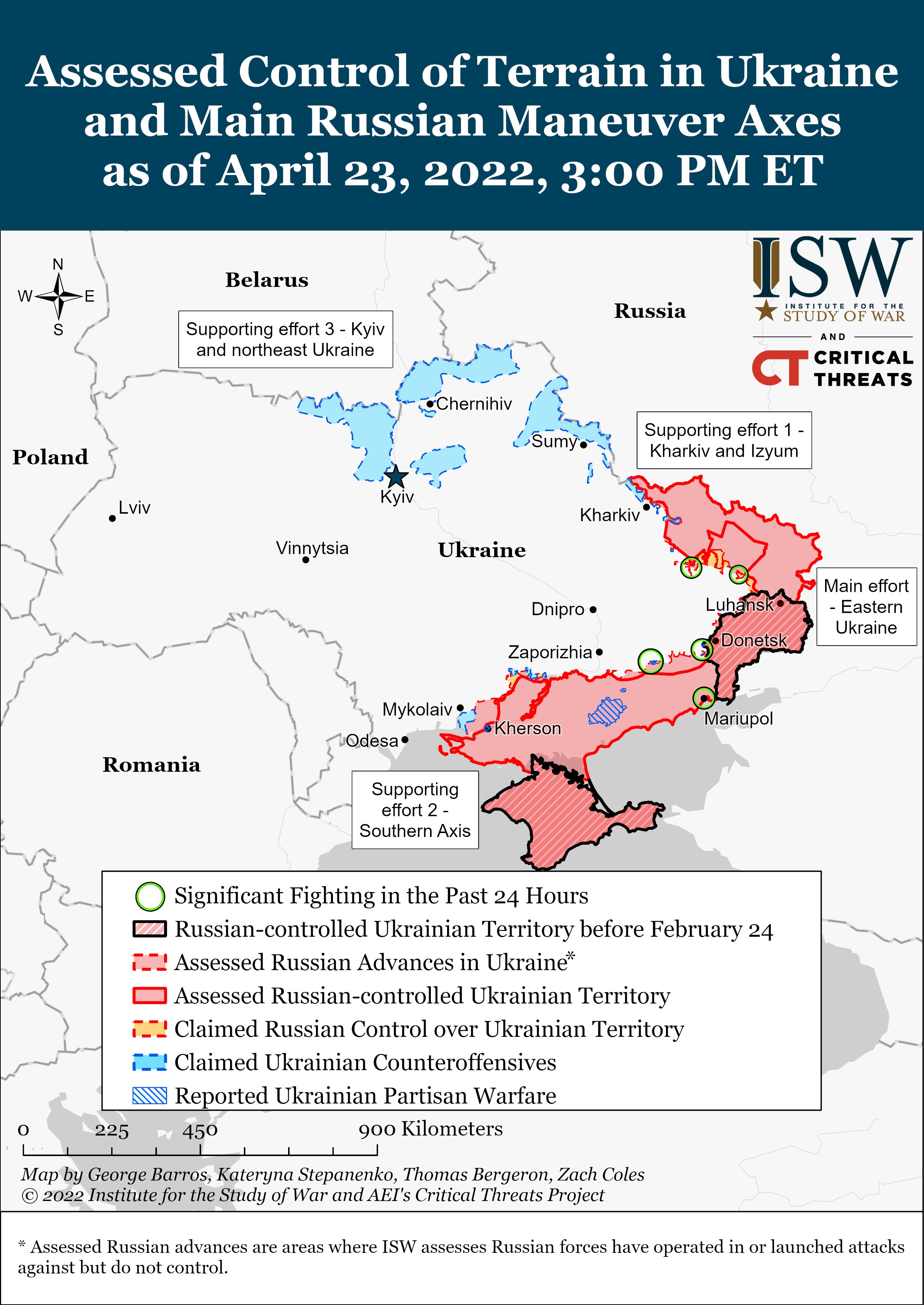 Russian forces continued offensive operations along multiple axes even as they completed moving reinforcements drawn from the retreat from #Kyiv into the east and continued redeploying some forces from #Mariupol to the north. www.understandingwar.org/...
Russian forces continued offensive operations along multiple axes even as they completed moving reinforcements drawn from the retreat from #Kyiv into the east and continued redeploying some forces from #Mariupol to the north. www.understandingwar.org/...
-
The US secretary of state, Antony Blinken, and defence secretary, Lloyd Austin, will travel to Kyiv to meet the Ukrainian president, Volodymyr Zelenskiy, on Sunday. It will be the first high-level US trip to the city since the war began on 24 February.
-
Zelenskiy, at a press conference on Saturday held in an underground metro station, said Ukraine will ask the US for more heavy weapons to defeat Russia. “As soon as we have [more weapons], as soon as there are enough of them, believe me, we will immediately retake this or that territory, which is temporarily occupied,” Zelenskiy said.
-
Ukraine’s president also spoke at length about possible peace negotiations with Russia, saying if Moscow kills any Mariupol defenders – or goes forward with the independence referendum in the partly occupied southern regions of Kherson and Zaporizhzhia – Ukraine will suspend peace negotiations with Moscow.
-
In attacks on the eve of Orthodox Easter, Russian forces pounded cities and towns in southern and eastern Ukraine. A three-month-old baby was among eight people killed when Russia fired cruise missiles at the Black Sea port city of Odesa, officials said. Eighteen more were wounded.
-
Separate strikes in Girske, a village in the eastern Lugansk region, killed six civilians, the region’s governor, Sergiy Gayday, said.
-
Two Russian generals were killed near Kherson, the Ukrainian ministry of defence said in a statement. Another is in critical condition. The Ukrainian military on Friday hit the command post of Russia’s 49th army near the occupied regional capital, the ministry said.
-

The US-based Institute for the Study of War has released its latest analysis, warning that Russian forces will likely increase the scale of ground offensive operations in the coming days. It predicts that Russia will likely continue attacking south-east from Izyum, west from Kreminna and Popasna, and north from Donetsk via Avdiivka or another axis. Russian forces will attempt to starve out the remaining defenders of the Azovstal steel plant in Mariupol and will not allow trapped civilians to evacuate, it adds.
-
Satellite images released this week showed what appeared to be two recently excavated mass grave sites next to cemeteries in two towns near Mariupol, and local officials accused Russia of burying thousands of civilians to conceal the slaughter taking place there. The Kremlin has not commented on the images.
-
Russia said it took control of several villages elsewhere in the eastern Donbas region and destroyed 11 Ukrainian military targets on Saturday, including three artillery warehouses. Russian attacks also struck populated areas.
-
The UK Ministry of Defence released an intelligence update detailing accusations that Russia is planning to conscript Ukrainian civilians in the Kherson and Zaporizhzhia regions.
www.theguardian.com/...
ISW has updated its assessment of the four primary efforts Russian forces are engaged in at this time:
- Main effort—Eastern Ukraine (comprised of two subordinate supporting efforts);
- Supporting effort 1—Kharkiv and Izyum;
- Supporting effort 2—Southern axis;
- Supporting effort 3—Sumy and northeastern Ukraine.
 Subordinate Main Effort—Mariupol (Russian Objective: Capture Mariupol and reduce the Ukrainian defenders)
Subordinate Main Effort—Mariupol (Russian Objective: Capture Mariupol and reduce the Ukrainian defenders)
Russian forces continued to attack Ukrainian defenders in the Azovstal Steel Plant and are likely attempting to starve out those remaining within the facility.[2] Advisor to the Head of the Ukrainian President’s Office Oleksiy Arestovych stated that Russian troops tried to storm the plant and “strangle” Ukrainian resistance, though ISW cannot independently verify this claim.[3] Russian forces allegedly organized buses for civilian evacuation from Mariupol but canceled the evacuation on the grounds that Ukrainian ”nationalists” were planning on attacking the civilians.[4] Such actions that spoil the evacuation process likely represent further attempts to shape the information space in Mariupol and globally, as well as to extend administrative control in captured portions of the city.[5] www.understandingwar.org/...
Supporting Effort #1—Kharkiv and Izyum: (Russian Objective: Advance southeast to support Russian operations in Luhansk Oblast; defend ground lines of communication (GLOCs) to the Izyum axis)
Russian forces conducted ground attacks from Izyum on April 23.[10] Arestovych said that Russian troops seized Lozova, approximately 100 km west of Izyum, on April 23.[11] The Ukrainian General Staff reported that elements of the 35th Combined Arms Army’s 1st Tank Army and the 68th Army Corps are participating in active combat in the area as of April 23.[12] The Ukrainian General Staff stated that elements of the 64th Separate Motorized Rifle Brigade of the 35th Combined Arms Army, which had fought in Bucha, are operating in the vicinity of Izyum.[13] Elements of the 64th Separate Motorized Rifle Brigade sustained losses while fighting on the Kyiv axis earlier in the invasion, redeployed to the Izyum axis quickly, and therefore likely add limited combat power to the fight.[14]
www.understandingwar.org/...
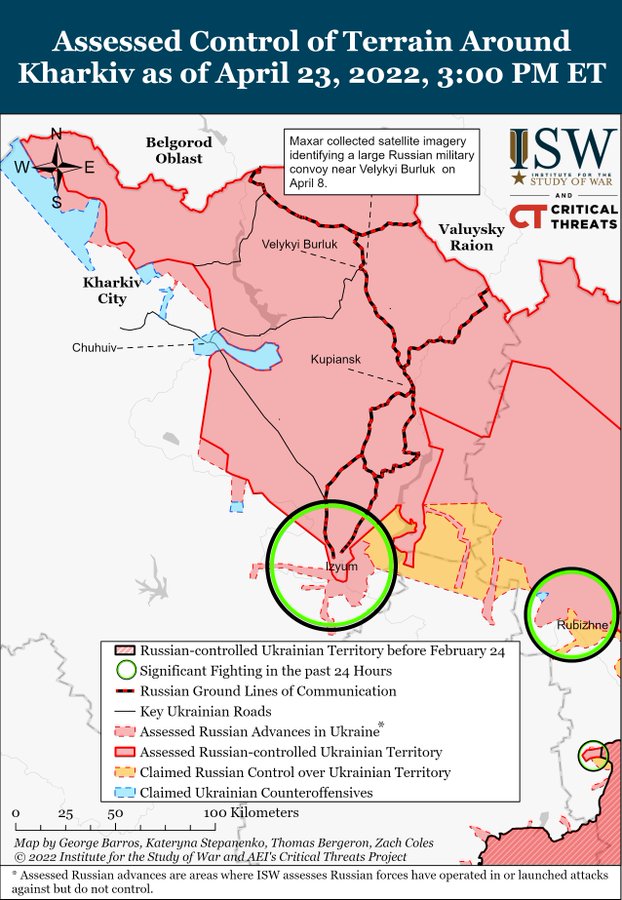 Russian forces maintained their positions northeast of Kharkiv city and continued to shell surrounding areas on April 23.[15] Reports of Russian reinforcements from the Kyiv axis in Kharkiv Oblast likely indicate that Russia intends to maintain pressure on Kharkiv city, contradicting the Russian claim that Moscow’s focus is on securing the borders of Luhansk and Donetsk oblasts. Russian ground lines of communication (GLOCs) do not currently run through or even near Kharkiv city, and the most recent Ukrainian counteroffensives near the city are unlikely to threaten Russian GLOCs from Belgorod to Izyum. www.understandingwar.org/...
Russian forces maintained their positions northeast of Kharkiv city and continued to shell surrounding areas on April 23.[15] Reports of Russian reinforcements from the Kyiv axis in Kharkiv Oblast likely indicate that Russia intends to maintain pressure on Kharkiv city, contradicting the Russian claim that Moscow’s focus is on securing the borders of Luhansk and Donetsk oblasts. Russian ground lines of communication (GLOCs) do not currently run through or even near Kharkiv city, and the most recent Ukrainian counteroffensives near the city are unlikely to threaten Russian GLOCs from Belgorod to Izyum. www.understandingwar.org/...
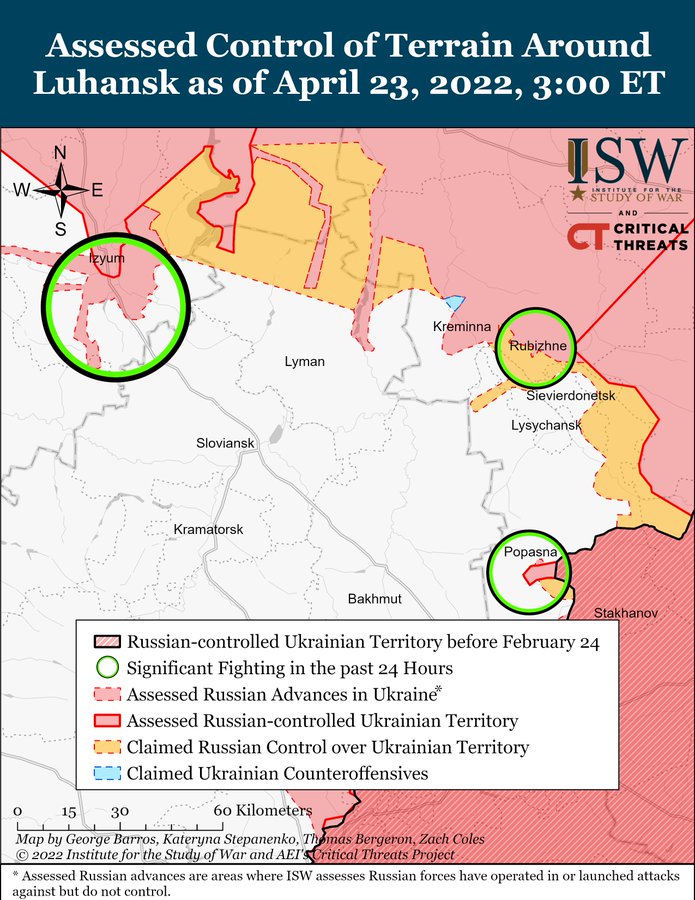 Subordinate Main Effort—Donetsk and Luhansk Oblasts (Russian objective: Capture the entirety of Donetsk and Luhansk oblasts, the claimed territory of Russia’s proxies in Donbas)
Subordinate Main Effort—Donetsk and Luhansk Oblasts (Russian objective: Capture the entirety of Donetsk and Luhansk oblasts, the claimed territory of Russia’s proxies in Donbas)
Russian forces conducted limited ground offensives in Rubizhne, Popasna, and Marinka on April 23 but did not make any significant territorial gains.[6] The Ukrainian General Staff said that Russian forces are focusing on preparing to assault Severodonetsk while continuing unsuccessful ground attacks in the direction of Slovyansk and shelling settlements all along the frontline.[7] Social media users and foreign journalists geolocated Russian forces to the northeastern part of Rubizhne, where street fighting continued as of April 23.[8] Russian forces paused offensive operations on Avdiivka, just north of Donetsk City, after consistently targeting the settlement throughout the week. Donetsk People’s Republic (DNR) and Russian units have reportedly been arriving in the vicinity of Donetsk City from Mariupol since April 21, and the Russian command will likely recommit these degraded units to offensives in Donetsk and Luhansk oblasts.[9] www.understandingwar.org/...

2/25 I will conduct my analysis using the construct of ‘fighting power’. This is something we use in the Australian Army to describe the optimal development & combination of the intellectual, physical and moral aspects of war. More here:
researchcentre.army.gov.au/sites/default/…3/25 The intellectual component of fighting power is knowledge and it application - of war, warfare, tactics, logistics, command and control. This includes organisational concepts, building a learning culture, adaptation, etc.
4/25 The physical component is a military organisations capabilities and functional effects. This includes equipment, training infrastructure, weapons, ammunition, trucks (HT
@TrentTelenko), personal equipment, sensors, physical comms networks, etc.
5/25 Finally, the moral component is all about culture, values and legitimacy. Importantly, it includes
#leadership, purpose, and the will to fight of individuals and teams.
6/25 The best military institutions are able to develop each of these components, adapt them based on experience and learning, and combine them in optimal ways (different for every operation) in order to succeed at their missions.
7/25 Key intellectual aspects that the have Russians demonstrated – in the east but throughout their invasion – have included the BTG as the core fighting formation, the ability to use ground and air power (but not well integrated) and to conduct warfare on multiple fronts.
8/25 However, there are many shortfalls in this intellectual component which will tell in their eastern operations. The Russians have not provided suitable logistic support to their combat forces. Nor have they demonstrated the capacity to integrate air and land operations well.
9/25 While some sources have noted additional logistic units deploying to the east, and Russian air sorties have increased, these fall short of a systemic fix. The air and logistic problems weren’t just a quantity issue – they are a systemic problem. These take time to fix.
10/25 Intellectually, the Russians used their combat forces piecemeal, feeding them into the fight slowly rather than generating large, powerful main efforts to achieve not just tactical success, but operational breakthroughs. This has been a significant intellectual failing.
11/25 Their application of combined arms warfare appears to have been sub optimal. Tanks have been employed by themselves without infantry, engineer, aviation support. Once again, this goes against all the lessons of modern combined arms warfare. (Image -
@UAWeapons)

12/25 Their approach to command & control is also a problem in the intellectual domain. Russia's initial approach was to fight 3 separate wars in the north, east & south - & another in the air. Russia seeks to fix this with the appointment of a unified commander – GEN Dvornikov.
13/25 But, without a well-structured joint headquarters, trained staff, a joint culture and a functional command and control system (including communications), this may be too little, too late to enable the Russian offensive in the east.
14/25 What about the physical component of fighting power? This is a topic that needs to be caveated up front because we don’t have perfect clarity on the size of the opposing forces in the east. So my analysis uses only open source information only.
15/25 Also, there are many who caution against using force ratios as a basis for planning. I understand the reasons for this (I helped rewrite Army doctrine and have been a combat brigade commander). That said, they remain useful rough order of magnitude guides for planning.
16/25 That said, the Russians do not appear to have sufficient mass to achieve a significant breakthrough in the east, despite the indications that they now have upwards of 80 BTGs there. And, as
@kofman_michael notes, because of their losses, it is not clear what a BTG is now.
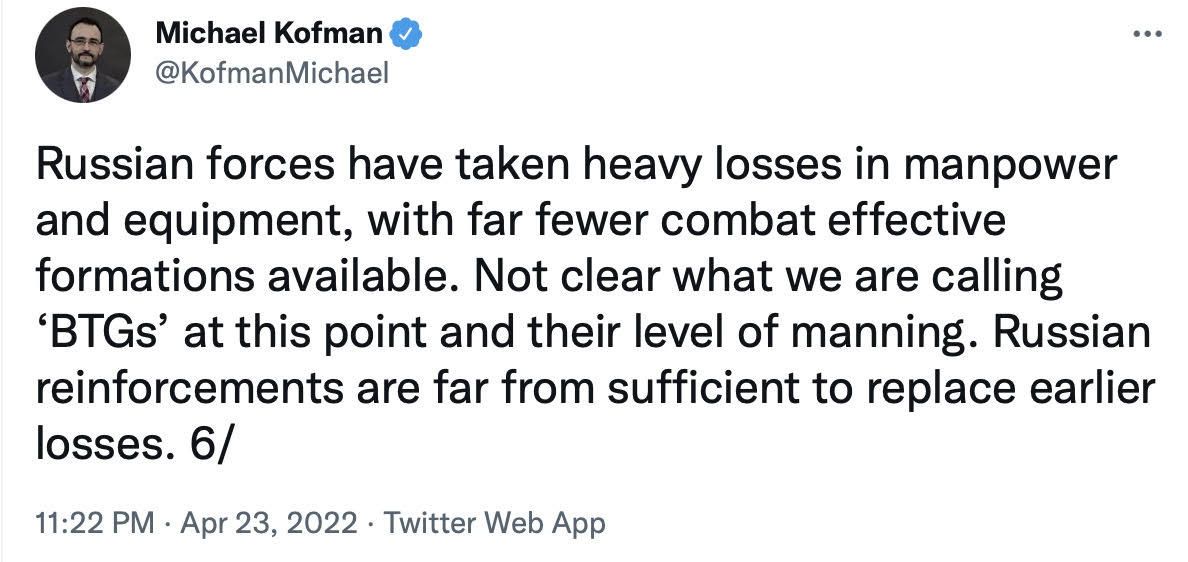
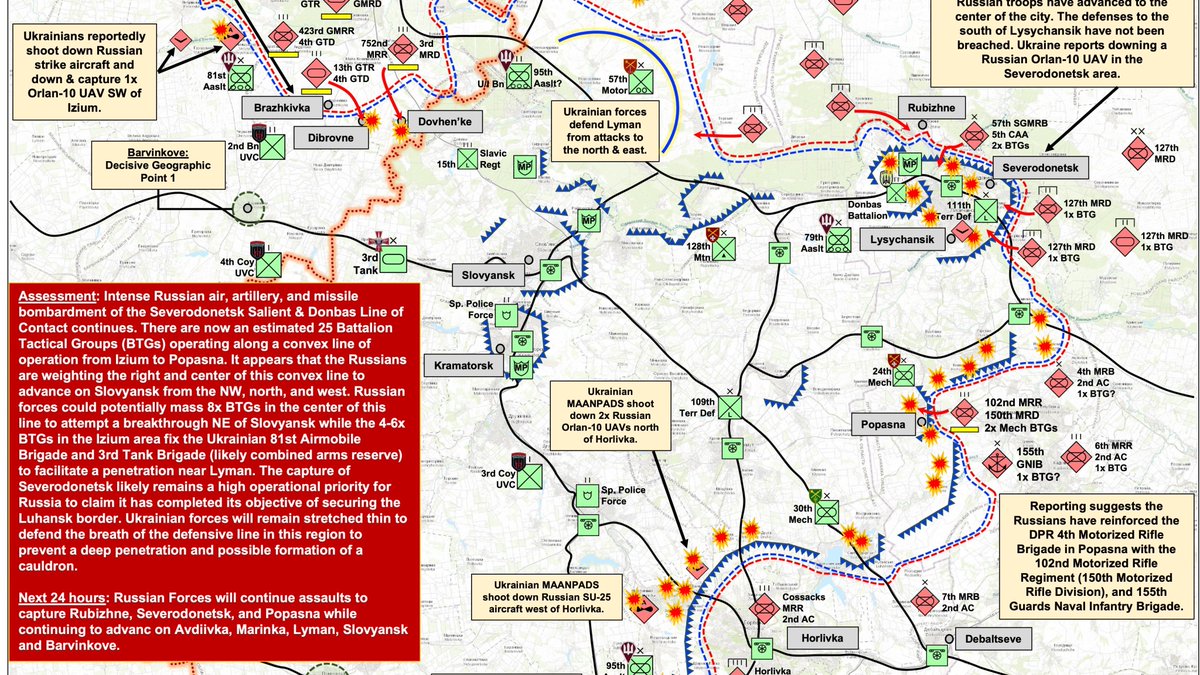
17/25 Opposing them, there are (according to several sources) up to 15 Ukrainian brigades, each of which has 3-5 combat battalions. This gives them somewhere between 45 and 75 battalion sized organisations opposing the Russians. (Image -
@JominiW)
18/25 In such an operation, the Russians need to deploy forces of at least a 3:1 ratio to the defenders. They don’t come anywhere near this. And, by the way, this assumes Russian attacking forces are well led, supplied & coordinated. As we saw in the north, this is unlikely.
19/25 So, in addition to intellectual shortfalls in their fighting power, the Russians lack the physical wherewithal for significant breakthroughs in the east. While there are things we are not seeing, the ‘Donbas Maths’ don’t work in Russia’s favour for a large-scale offensive.
20/25 Finally, the moral component of fighting power. This includes Russian military culture, leadership and will. As we have seen, the Russian military culture is one that is brutal and representative of their behaviour in WW2, Afghanistan, Chechnya and Syria.
21/25 This military culture, and the atrocious behaviour it spawns, has delegitimised Russian operations (even more than their illegal invasion). It also means they are less effective as a military force, and less capable at achieving difficult military objectives.
22/25 But, perhaps leadership is the area most lacking in the moral component of Russian fighting power. Their strategic leaders planned this war poorly and have incentivised systemic targeting of cities and civilians.
23/25 At the tactical level, bad leaders have been responsible for the intellectual failings described earlier in the thread. This is a systemic problem with training, education, and organisational culture. It will not be fixed in the coming weeks.
24/25 Taken together, these three elements of Russian fighting power do not appear to support the prospect of any major Russian gains from their eastern offensive. There may be some successes, but there are multiple challenges that suggest things don't bode well for the Russians.
25/25 That does not mean the Russians are not dangerous, or that they won’t hold onto ground already seized in Ukraine. The Ukrainians are also very capable of mounting an offensive in the east. I will explore these topics in threads this week. End (Image -
@War_Mapper)
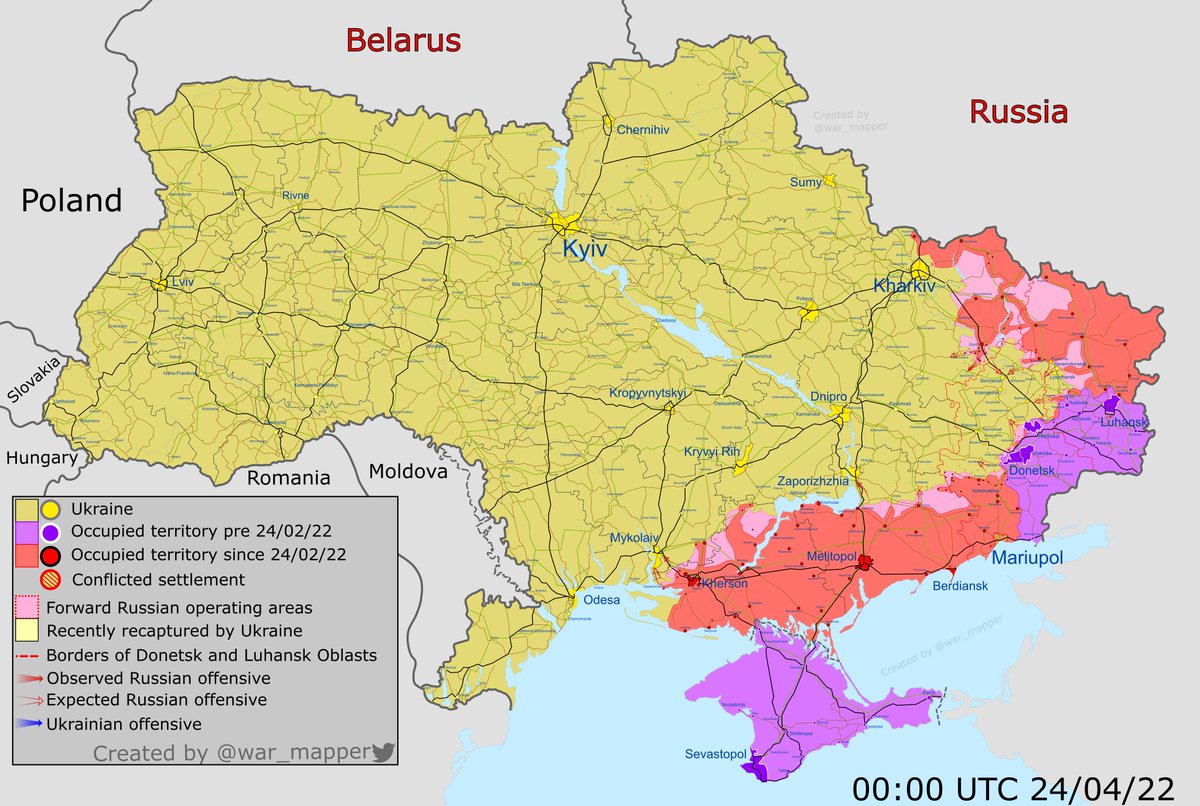
• • •


Without national mobilization, I think the Donbas is the last major offensive the Russian military can attempt given the current state & availability of forces. Whether it succeeds, or fails, the Russian military will be largely exhausted in terms of offensive potential. 2/
The Russian attack thus far seems to be an advance on Slovyansk from Izyum, pressing the Severodonetsk salient, and pushing southwest from Izyum (west of Kramatorsk) to attempt a partial envelopment of UKR positions in the northern part of the Donbas. 3/
This is a risky operation. UKR forces have been reinforcing around Kharkiv, and attacking to threaten the Russian ground lines of communication for this offensive. Even if Russian forces make significant gains, they could be pressed to hold territory and vulnerable afterwards. 4/
UKR forces appear to have conducted a tactical retreat in some areas, blown bridges, and at the same time could position for a counter attack to threaten the sustainment of the Russian offensive. 5/
Russian forces have taken heavy losses in manpower and equipment, with far fewer combat effective formations available. Not clear what we are calling ‘BTGs’ at this point and their level of manning. Russian reinforcements are far from sufficient to replace earlier losses. 6/
In the south, Russian forces had been tied down in Mariupol. Putin’s announcement that they are going to avoid storming Azovstal probably reflects that they can’t afford to lose further manpower and need those units for the Donbas offensive. 7/
Even still, it’s unclear if the southern axis of the planned offensive will be more than a fixing action. The Southern Military District's forces have been mauled over 2 months of fighting. This means a larger operational envelopment is probably beyond their means to support. 8/
Russian forces in the southwest around Kherson city are struggling to consolidate a defensible perimeter west of the river. The units deployed there are relatively light, and under pressure. They could even be forced over time to retreat east across the Dnipro. 9/
Ukraine has been deploying reinforcements to Zaporizhia, Donbas & Kharkiv. Russia has made little effort to disrupt ground lines of communication into the Donbas. This means that a Russian success is at best contingent & UKR could be in position to launch counteroffensives. 10/
Expansion of support to include armor, IFVs, and artillery is going to allow Ukraine to replace losses and equip reserve brigades (esp artillery and ammunition which Ukraine needs). Hence the general trajectory of correlation of forces in this war is not in Russia’s favor. 11/
If the Russian military sends units in piecemeal, sticking to roads, with narrow advances – they will be defeated by UKR as they have in other battles. I’ve seen them make adjustments in some areas, but some of the problems are structural. 12/
Reticent to make any predictions on how the battle for the Donbas will go. These things are contingent, and it depends. The outcome can range from Russian forces making gains to suffering another significant defeat. 13/
Dvornikov's appointment changes little. There’s not much distinguishing him from other Russian generals. The more pertinent question is how/if the Russian military has reorganized command and control, air support, and logistics for this offensive. 14/
Donbas is a relatively urban region. Russian forces likely need Severodonetsk to control Luhansk and Slovyansk + Kramatorsk in order to claim they have captured Donetsk. These could end up prolonged and costly fights in urban terrain. 15/
I think it is fair to say that the decisive period of the war was the first three weeks (maybe even first 4 days). Whatever happens in this next phase, the Russian military is likely to exhaust its offensive potential in the near term. 16/
Does this presage a stalemate? Not necessarily. UKR has its own offensive options. Russia may next try to consolidate control over territory held and pressure UKR via blockade. Its too early to predict what the next phase might look like & it depends on what UKR chooses to do.
Sorry opening post should say 'take' not 'retake' - blame jetlag.
I’m going to make another follow up thread on force availability, with some added info since the last time I addressed that subject.
• • •
The Defense Department on Friday posted a broad request for information from industry on the federal contracting website sam.gov. The move is part of a stepped-up dialogue between the Pentagon and industry, and a sign of the challenge of boosting arms production in response to the ongoing conflict.
The RFI, on behalf of the new undersecretary of defense for acquisitions and sustainment, Bill LaPlante, is seeking input “from across industry” about air defense, anti-armor, anti-personnel, coastal defense, counter battery, unmanned aerial systems, and communications equipment, such as secure radios and satellite internet gear.
To that end, the DoD asks that responding companies describe their weapon, product or system in 100 words or less, and ― in the case of munitions ― check off “appropriate target type(s),” such as area, fixed, airborne/missile, maritime, mine, moving, hard or soft. The RFI says information received will be used to develop requirements for an actual solicitation at a later date.
RFIs are a standard tool used ahead of contracting actions, but it’s one the Pentagon relies on in both routine situations and emergencies.
www.defensenews.com/...


